I like Metal art community. Why? I don’t know…
Maybe it because there are interesting art projects and fascinating history of the building – the first train station in the world…
Maybe it because lovely people there in community…
I found very interesting information about Edge Hill Station from history of it.
The original Edge Hill station on Stephenson's 1826-30 Liverpool to Manchester line, had a magnificent Moorish arch and was set deep in a sandstone cutting. The Crown Street terminus was too far from the city and a new terminus at Lime Street and this new Edge Hill station both opened in 1836. Trains were able to descend to Lime Street by gravity and were rope-hauled by a winding engine up to Edge Hill.
The station consists of two island platforms, each with an original building of 1836, making this possibly the oldest station in continuous use and in its original form in the world.
The original Edge Hill station on Stephenson's 1826-30 Liverpool to Manchester line, had a magnificent Moorish arch and was set deep in a sandstone cutting. The Crown Street terminus was too far from the city and a new terminus at Lime Street and this new Edge Hill station both opened in 1836. Trains were able to descend to Lime Street by gravity and were rope-hauled by a winding engine up to Edge Hill.
The station consists of two island platforms, each with an original building of 1836, making this possibly the oldest station in continuous use and in its original form in the world.
The locomotives would run as far as Edge Hill cutting where they would be detached with loaded coaches being cable hauled through a short tunnel by winding engines at the passenger terminus at Crown Street; returning coaches ran down to Edge Hill by gravity. Goods traffic was handled at the Wapping Goods station close to Liverpool Docks. This was reached by an impressive 2030 metre tunnel from Edge Hill cutting; wagons were cable hauled up from Wapping and descended by gravity
The Crown Street passenger terminus soon proved inadequate due to its size and distance from the city centre and it was closed on 15th August 1836 on the opening of a new terminus at Lime Street, much closer to the city centre. This was reached by a new double track 1006 metre tunnel; although the new line was less steep than Wapping it was still cable hauled. A new engine house was built at Edge Hill, in what is now the station building. Steam for this engine was supplied from a boiler in the old Edge Hill cutting through a long tunnel excavated through the sandstone on the north side of the cutting; this was known as the 'steam tunnel'; the boiler was housed in a chamber cut into the cutting wall. Goods and coal traffic continued to be handled at the old Crown Street station and a second wider tunnel into Crown Street was driven in about 1846. In the 1860's in order to facilitate a new track alignment the Edge Hill cutting w! as widened forcing the demolition of the Moorish Arch.
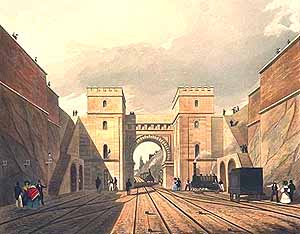
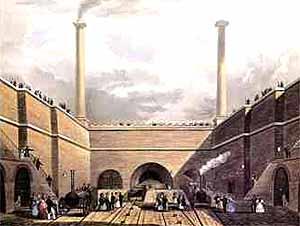
From 1870, the line into Lime Street was locomotive hauled and a huge chimney with a powered fan was built on Smithdown Lane, near Edge Hill. This was only used for a few years although the chimney lasted until just before WW2. Smoke in the tunnel was always a problem so after a couple of accidents and the need for increased traffic, the two track tunnel was opened up into a deep four track cutting with seven short lengths of tunnel remaining to support various roads and houses. At Edge Hill a further tunnel opened in 1849, north of the Lime Street tunnel. This was another ambitious undertaking comprising two end on tunnels collectively known as Waterloo.
The Waterloo Tunnel at 862 metres is, in reality, the shorter of the two tunnels. Immediately to the west of it is the longer Victoria Tunnel at 2475 metres. The tunnels ran north west to Waterloo Goods Station and the harbour railway system and were, again, cable hauled from Edge Hill.
Cable haulage continued through the Waterloo Tunnel until 1895 when it went over to locomotive haulage and the line was extended to a new passenger station, Riverside, near the pier head, The Wapping Tunnel went over to locomotive haulage the following year. Waterloo Goods Station remained in use until 1963 while Crown Street goods terminal lasted a further five years, closing in 1968; the site was landscaped in 1980.
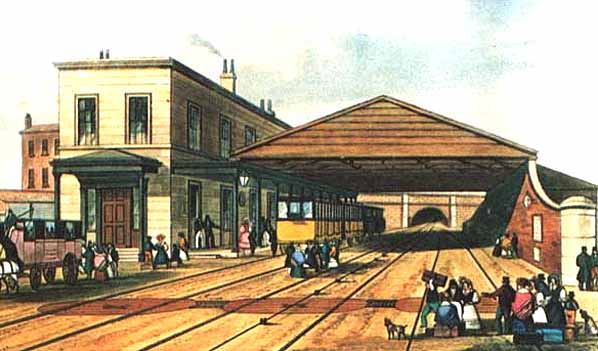
At the western end three tunnels enter the west wall of the cutting. The northernmost (the 'Stephenson' tunnel) to Crown Street and the central one to Wapping date from the opening of the line while the southernmost tunnel was driven through an original storage recess in about 1846 and was further opened up when the south cutting wall was cut back by three metres after 1864 to accommodate an extra track. Of the three tunnels the Stephenson tunnel is the smallest, being 5.15 metres high to the crown of the arch, and 4.60 metres wide. At the far end, which is now blocked, there is a date stone of 1829 set into the roof. There is also a hole in the floor dropping down into the roof of the Wapping Tunnel. The tunnel is cut through solid rock and unlined with brick arching; internally it is in good condition with a large quantity of long stalactites hanging from the roof.
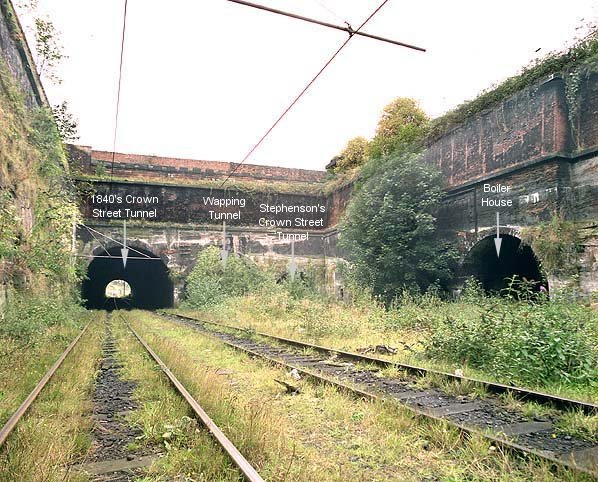
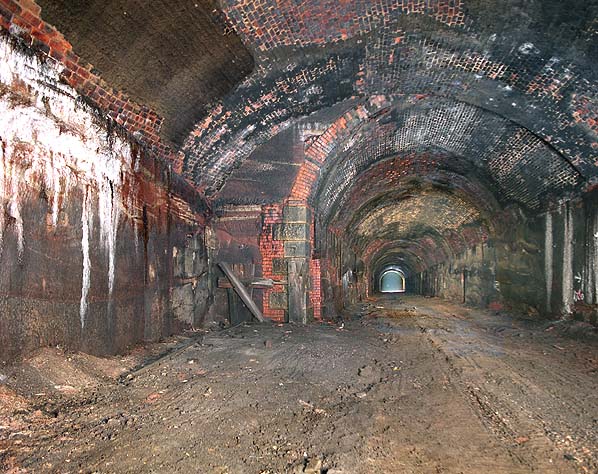
Many Thanks to Nick Catford for this pictures and info on this page.
www.subbrit.org.uk/sb-sites/index.shtml
http://www.hows.org.uk/personal/rail/incline/lls.htm
What a fascinating history! There are so many unknown and uncharted tunnels under the ground.
That first step's a doozy.
All the roots hang down, swing from town to town
They are marching around down under your boots
all the trucks unload beyond the gopher holes
There's a world going on underground.
— Tom Waits, "Underground"
source of pictures unknown
I found on youtube amazing short film about a 'Princess Elizabeth' - Steam Train.
The 'Princess Elizabeth' steam train was leaving from Euston station, London, returning to Merseyside, during a trip down south. The 'Princess Elizabeth' locomotive became part of the service that ran between London to Liverpool in the 1930's.
For many years steam train was based at Edge Hill in Liverpool depot in Liverpool. The train also had the distinction of holding the 'Merseyside Express' headboard on numerous occasions.
It woke my memory up about my childhood and how I was scared those big, noisy steam trains when I was little girl and traveled with family by train to visit grandmother.
The short film worth a watch, the sound was amazing, could hear it half way up the cutting it was that loud, and all that steam everywhere!
http://www.youtube.com/watch?v=XBqekhfRt-Q&noredirect=1image source: http://glostransporthistory.visit-gloucestershire.co.uk/RR_46201%20Princess%20Elizabeth.htm











































































































